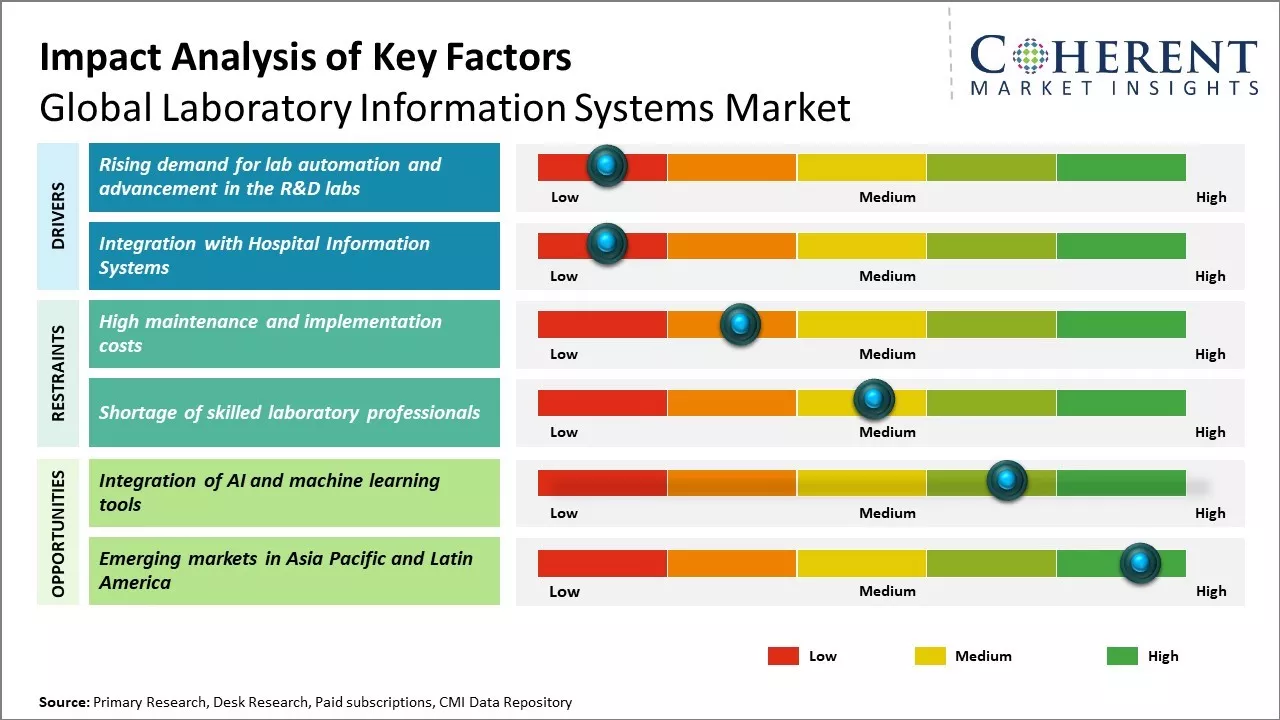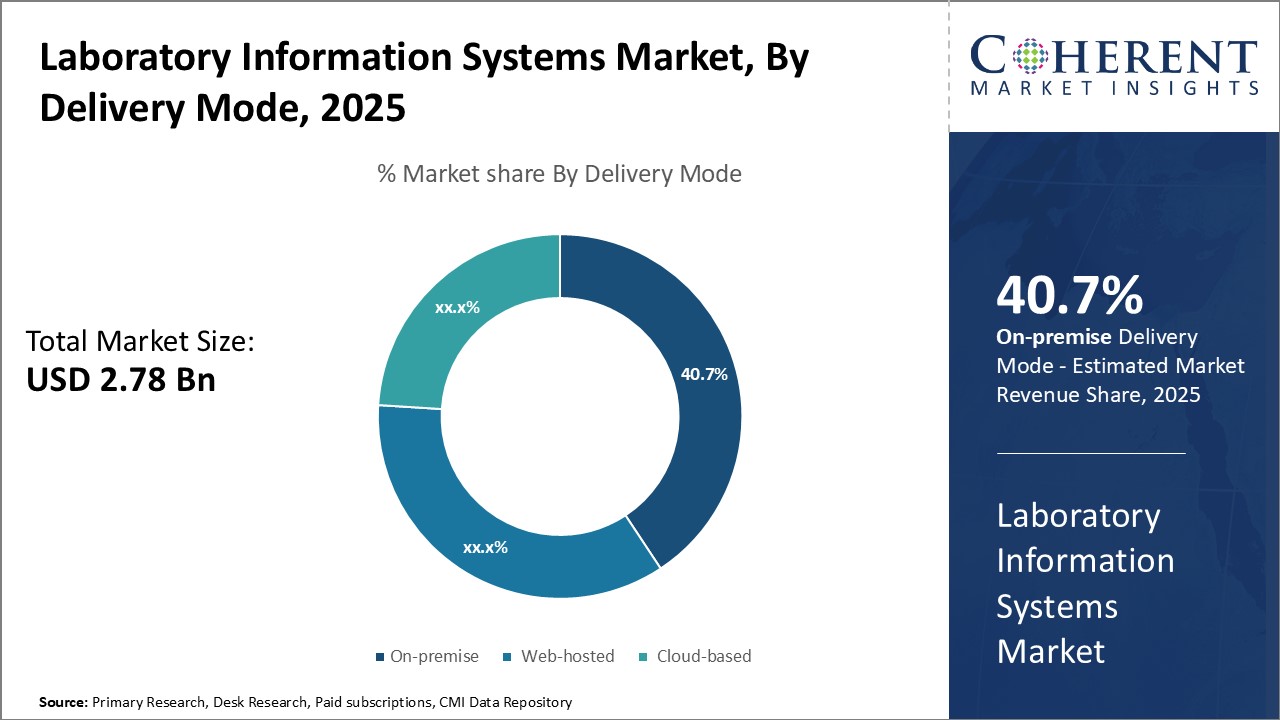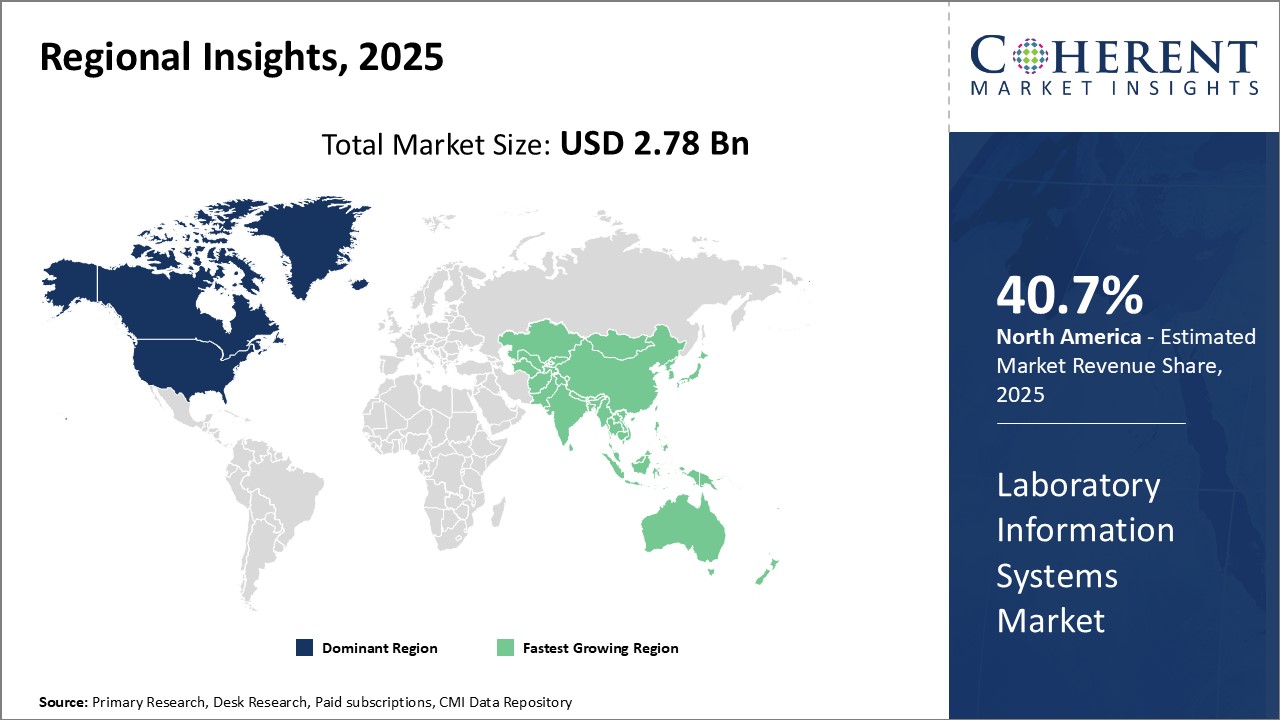Global laboratory information systems market is estimated to be valued at USD 2.78 Bn in 2025 and is expected to reach USD 5.48 Bn by 2032, exhibiting a compound annual growth rate (CAGR) of 10% from 2025 to 2032. Rising chronic diseases, growing geriatric population and increasing preference for online consultations and e-pharmacies can drive the laboratory information systems market growth.

Discover market dynamics shaping the industry: Request sample copy
Global laboratory information systems market growth is driven by need for healthcare organizations to meet regulatory compliance, improve diagnostic accuracy and enable better data management using information technology. Growing adoption of digital healthcare and benefits of integration with other hospital information systems such as reduced medical errors, availability of reports and modernizing laboratory operations can boost investments and demand for core laboratory information systems. Vendors are focusing on launching innovative product upgrades that leverage artificial intelligence, cloud computing and mobile technologies to provide healthcare organizations seamless data analytics workflow and workflow efficiency. Integration of laboratory information systems with laboratory instruments and diagnostic technologies allows real-time data transfer between different systems.
Rising demand for lab automation and advancement in the R&D labs
Rising demand for lab automation and digitalization of processes within research and development laboratories can drive the market growth. Laboratories are under increasing pressure to improve efficiency, reduce manual errors, and deliver accurate test results faster than before. This has led to rising investments in automated tools, equipment, and software systems that can streamline operations within labs. There has been increase in adoption of advanced technologies like automated liquid handling machines, microplate readers, and digital data collection platforms. These allow for walk-away sample preparation, analysis, and standardized electronic data capture. This significantly boosts productivity and throughput while minimizing human error risks. Leading global life sciences labs are at the forefront of automation technology implementation to support their complex research on diseases. For instance, in 2020, according to a survey conducted by Astrix Technologies LLC, a leading healthcare IT service provider, significant benefits were reported by users of laboratory information management systems. 61% people noted increased efficiency from eliminating manual operations, 57% improved their sample management practices, and 46% witnessed notable productivity gains in their labs. 77% of surveyed organizations currently have a LIMS implemented in their laboratories. Most of these organizations have more than 25 users, and 30% use between 3 to 5 different types of LIMS across their implementations. 36% of respondents expressed high satisfaction with their LIMS, and 44% highlighted substantial improvements in laboratory efficiency. These findings underscore the growing effectiveness of laboratory informatics within the healthcare sector.

Get actionable strategies to beat competition: Request sample copy
Integration with hospital information systems
Integration with hospital information systems has boosted demand for laboratory information systems globally. With growing need for hospitals and diagnostic centers to streamline operations and enhance efficiency, there has been an increased focus on integrating laboratory software with existing hospital information systems (HIS). This integration allows for seamless exchange of patient and test details between the labs and other clinical departments like pharmacy, radiology. It eliminates the need for duplicating patient data entry, reduces turnaround time for test reports and ensures test results are promptly available to clinicians. Many large hospitals have implemented laboratory information systems that are seamlessly integrated with their HIS platforms. This integrated approach enables facilities to maintain centralized patient records and test history. It also helps in better monitoring and management of workflows. According to the World Health Organization, the average turnaround time for medical test reports had reduced by over 30% in public hospitals across developing nations that deployed integrated laboratory-hospital information systems between 2020-2022. The new collaborative work environment empowered caregivers with quick access to accurate diagnostic insights, thus, enhancing patient care quality.
Key Takeaways from Analyst:
Global laboratory information systems market growth is driven by increasing demand for laboratory automation and integration of various diagnostic processes. Growing need to improve lab efficiency and minimize errors prompts more labs to adopt LIS solutions. However, high costs of installation, maintenance and upgradation of these systems may limit larger labs and hospitals in developing nations to buy new LIS.
North America dominates the market due to robust healthcare infrastructure and rising expenditure on healthcare IT in the region. However, Asia Pacific is expected to emerge as the fastest growing regional market due to modernization of healthcare systems and booming medical tourism industry in countries like India, China and Singapore. The rapidly developing biopharmaceutical and life sciences industries in Asia Pacific can offer growth opportunities.
New product launches with advanced features integrating artificial intelligence and internet of things capabilities are expanding avenues for existing as well as new vendors. Growing trends of laboratory decentralization and emphasis on precision medicine can offer opportunities for LIS providers to integrate diverse sets of technologies and data across larger healthcare networks. However, vendors need to address issues around data security, connectivity, standardization and scalability to succeed in this dynamic market.
Market Challenges: High maintenance and implementation costs
The high maintenance and implementation costs associated with laboratory information systems can hamper the global laboratory information systems market growth. Laboratory information systems are complex integrated software solutions that require a sizable capital investment and include high total cost of ownership. The implementation of LIS involves procuring specialized hardware, software licenses, customization according to the lab's unique requirements and extensive workflow integration with other existing IT systems. This implementation process can stretch over several months and requires dedicated teams of experts, engineers and consultants. Thus, upfront capital costs of installing a new LIS or upgrading an existing one runs into several millions of dollars for large hospitals and clinical labs.
Market Opportunities: Integration of AI and machine learning tools
The integration of artificial intelligence and machine learning tools can provide significant opportunities for the global laboratory information systems market growth. These advanced technologies have the power to automate various repetitive and manual tasks, allowing laboratories to streamline their operations while improving productivity and efficiency. AI and ML algorithms can analyze huge volumes of complex data from different diagnostics and testing instruments to generate valuable insights. This data-driven decision making can help laboratories reduce turnaround time for test reports, enhance diagnostic accuracy, and optimize resource utilization. AI tools that can perform digital slide scanning of histopathology samples can assist pathologists by pre-screening slides and flagging areas that likely contain cancerous cells. This helps reduce the subjective variability between pathologists and expedites the diagnosis process. Machine learning models trained on molecular testing data can identify patterns to predict the development of certain diseases in high-risk patients. This enables proactive interventions and customized treatment protocols. The integration of automated specimen tracking capabilities based on image recognition and sensors can also help laboratories reduce manual errors and ensure smooth workflow.

Discover high revenue pocket segments and roadmap to it: Request sample copy
Insights, By Delivery Mode - Rapid digitalization boosts adoption of cloud-based
In terms of delivery mode, cloud-based segment is estimated to contribute the highest market share of 40.7% in 2025. Healthcare institutions are under increasing pressure to reduce costs while improving quality of care. Cloud-based LIS allow hospitals and labs to avoid large upfront capital expenditures and receive predictable operational expenditures. This has boosted adoption for cloud-based LIS among cash-strapped public hospitals. Furthermore, the workforce is becoming increasingly mobile. Cloud-based LIS provide secure access to important medical records from any internet-connected device. This improves flexibility and drives efficiencies. Young doctors appreciate the mobility and ease-of-use offered by cloud solutions. Cloud vendors also provide regular software updates and new features through a simple subscription model. This ensures cloud customers always have the latest technologies without any additional work. The cost advantages along with modern features have made cloud-based the most attractive LIS solution.
Insights, By Component - Software dominates due to need for computational tools
In terms of component, software segment is estimated to contribute the highest market share of 60.12 % in 2025 due to the critical role of LIS programs. LIS software handles complex tasks like test ordering, specimen processing, results analyzing and record keeping. It serves as the central computational system that brings together diverse medical devices, drives automated workflows and generates analytical reports. Due to rising complexity and volume of healthcare data, there is a growing need for powerful software to help handle everything efficiently. Software vendors also continuously refine and expand features to address emerging pain points in labs. While services provide necessary support, it is the sophisticated software programs that act as the heart of LIS operations.
Insights, By End User – Hospital & clinics lead adoption to streamline in-house labs
In terms of end user, hospitals & clinics segment is estimated to contribute the highest market share of 45.6% in 2025 as hospitals operate large in-house laboratories that process high volumes of samples and tests round the clock. In such busy settings, LIS provide tangible benefits like consolidated test ordering, integrated device connections, digital sample tracking and automated result delivery. This significantly streamlines workflows and improves lab productivity. LIS also help enhance patient safety by reducing human errors. Their digitized record-keeping frees up staff from mundane documentation work. Furthermore, complex hospital labs dealing with diverse specialized tests greatly value the unifying platform of an LIS. Due to pressing need to maximize efficiency and quality of their lab services, hospitals are at the forefront of LIS adoption.

Need a Different Region or Segment? Customize now
North America has established itself as the dominant regional market with an estimated market share of 40.7% in 2025. With strong presence of key industry players and hospitals adopting advanced healthcare IT solutions, the U.S. and Canada account for over 40.5% of the global installed base. The region enjoys strong funding support from private and public insurers for digital transformation initiatives in healthcare sectors. Several large EHR vendors in the U.S. have also strengthened their LIS product suites through acquisitions, allowing for greater integration with other clinical systems.
The Asia Pacific region has emerged as the fastest growing market. Countries like China, India, Japan and South Korea are witnessing increasing investments from both public and private sectors to build world-class healthcare infrastructure. The governments of these nations recognize the importance of interoperable digital platforms for effective governance of vast patient data. This has boosted adoption of LIS across both small and large hospitals as well as independent clinical laboratories. Growing medical tourism and rising affluence has boosted demand for diagnostic services in Asia over the past decade.
Laboratory Information Systems Market Report Coverage
| Report Coverage | Details | ||
|---|---|---|---|
| Base Year: | 2024 | Market Size in 2025: | USD 2.78 Bn |
| Historical Data for: | 2020 To 2024 | Forecast Period: | 2025 To 2032 |
| Forecast Period 2025 to 2032 CAGR: | 10.2% | 2032 Value Projection: | USD 5.48 Bn |
| Geographies covered: |
|
||
| Segments covered: |
|
||
| Companies covered: |
Cerner Corporation, Sunquest Information Systems, Inc., CompuGroup Medical AG, McKesson Corporation, SSC Soft Computer, Orchard Software Corporation, Epic Systems Corporation, Meditech (Medical Information Technology, Inc.), Computer Programs and Systems, Inc. (CPSI), CliniSys Group Ltd., Merge Healthcare Incorporated (an IBM company), STARLIMS Corporation (a subsidiary of Abbott), Thermo Fisher Scientific Inc., Comp Pro Med, Inc., Schuyler House, LabWare, TechniData America, Siemens Healthineers |
||
| Growth Drivers: |
|
||
| Restraints & Challenges: |
|
||
Uncover macros and micros vetted on 75+ parameters: Get instant access to report
*Definition: Global Laboratory Information Systems market covers computerized systems that are used to manage data related to patient samples, test requests and results. These systems help laboratories to integrate and streamline their workflow processes and help ensure accurate patient testing and reporting. They automate workflow processes to reduce manual data entry errors and improve turnaround time and efficiency in laboratories.
Share
Share
About Author
Komal Dighe is a Management Consultant with over 8 years of experience in market research and consulting. She excels in managing and delivering high-quality insights and solutions in Health-tech Consulting reports. Her expertise encompasses conducting both primary and secondary research, effectively addressing client requirements, and excelling in market estimation and forecast. Her comprehensive approach ensures that clients receive thorough and accurate analyses, enabling them to make informed decisions and capitalize on market opportunities.
Missing comfort of reading report in your local language? Find your preferred language :
Transform your Strategy with Exclusive Trending Reports :
Frequently Asked Questions
Joining thousands of companies around the world committed to making the Excellent Business Solutions.
View All Our Clients
US Reciprocal Tax Impact Analysis On Laboratory Information Systems Market
Stay updated on tariff changes with expert insights and timely information